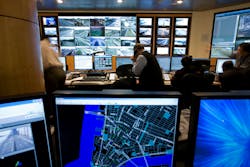How CSIM Can Facilitate Crisis Communications
It’s practically a given that the decisions organizations make during the window of time from when an emergency situation begins to when law enforcement arrives are crucial. Unfortunately, the time it takes to respond may not allow the type of intelligent decision-making that would improve outcomes in a crisis.
According to the Bureau of Justice Statistics, average police response times to emergency situations range from 11 minutes to an hour. Department of Homeland Security research reveals that the average duration of an active shooter incident at a school is 12.5 minutes, while the average time it takes for law enforcement to arrive is 18 minutes. (DHS)
When working to resolve a situation, effective communication and coordination among multiple sources include collecting sensor data from multiple vantage points, correlating the data, and then interpreting and sending those insights to first responders. The time it takes to respond to an emergency situation can mean the difference between life and death. That’s where a Converged Security and Information Management (CSIM) platform allows organizations to minimize the amount of time it takes to sort through data, determine appropriate actions and respond.
It’s All About Data
Data is undoubtedly one of our most powerful tools. However, a deluge of data without context is overwhelming and ineffective. In order to facilitate communications during a crisis, decision makers must be able to collect and interpret data to pull the most useful and actionable data out of the noise - and act upon this information.
CSIM technology brings together a common operating picture and situational awareness of all organizational assets. Based on customized rules and regulations, organizations can set parameters for what should be flagged as a “risk”. The first warning sign is usually unusual or unexpected activity - whether physically on your organization’s campus or virtually on your IT system.
By collecting data from disparate sensors, devices, systems, and subsystems, software tools are able to identify patterns that are unusual for any monitoring or sensor device.
Protect Your Borders
Organizations can create a safer environment through the provision of a robust access control system. The more secure a building is, the longer it will take for an intruder to enter the premises. Building in safeguards such as fewer entry access points, gated access to different parts of a building, RFID and in some cases biometrics, are all steps that building managers and organizations should consider.
Advanced security systems can track where employees and visitors are within a building and restrict certain areas to only specific levels of personnel. If needed, these systems can also lockdown entrances and exits within a building.
Geographic Information Systems (GIS) can also be of use to responders by providing an information map or your location, while also monitoring patterns to provide real-time, actionable responses. In the case of an intruder, GIS can provide a building floor plan, identify entry points for responders and aid in identifying the movement of the individual within the building. This allows security teams and law enforcement to make informed decisions before taking action. All of this information is displayed via a single pane of glass through a CSIM platform.
Video Facilitates Visual Recognition
Live video feeds are crucial for any organization, as they provide a visual tracking tool to determine important details about incidents. When an alarm is triggered, video cameras located closest to that particular site automatically display live footage at the command center. Video provides unparalleled information about how many active participants are involved, where they entered the building, and their current location.
CSIM pulls together the video data along with other information from access control, sensors, alarms, ID management, GIS, and other data sources to create a holistic sense of situational awareness and provide appropriate actions for true situation management.
While security sensors and video footage can help secure an organization, businesses can also leverage powerful technology to integrate their data and receive automated, intelligent information that eliminates the risk of human error and facilitates the security process - saving your organization money, time, and increased public safety.
About the Author: James I. Chong is CEO Co-Founder of Vidsys. He launched Vidsys in 2005 with its transformational security and information management software platform. Chong has over 20 years of management and technology experience in software, IT, video surveillance, security, and complex systems and is a world-class subject matter expert, entrepreneur, and innovator. His vision for developing a highly-specialized product-driven business with a focus on specific vertical market segments led to the development of several industry-leading software applications, including VidShield, RiskShield, and Intelligent Traffic Management System (ITMS).




